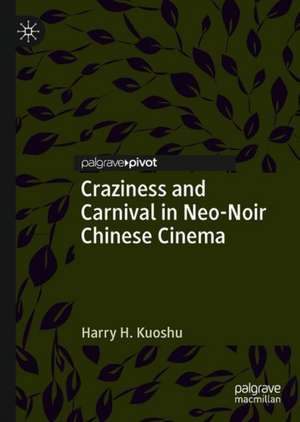Craziness and Carnival in Neo-Noir Chinese Cinema: Chinese Literature and Culture in the World
Autor Harry H. Kuoshuen Limba Engleză Hardback – 21 apr 2021
Preț: 485.24 lei
Nou
Puncte Express: 728
Preț estimativ în valută:
92.85€ • 97.14$ • 77.13£
92.85€ • 97.14$ • 77.13£
Carte tipărită la comandă
Livrare economică 02-16 aprilie
Preluare comenzi: 021 569.72.76
Specificații
ISBN-13: 9783030730802
ISBN-10: 3030730808
Pagini: 158
Ilustrații: XI, 158 p. 15 illus. in color.
Dimensiuni: 148 x 210 mm
Greutate: 0.36 kg
Ediția:1st ed. 2021
Editura: Springer International Publishing
Colecția Palgrave Macmillan
Seria Chinese Literature and Culture in the World
Locul publicării:Cham, Switzerland
ISBN-10: 3030730808
Pagini: 158
Ilustrații: XI, 158 p. 15 illus. in color.
Dimensiuni: 148 x 210 mm
Greutate: 0.36 kg
Ediția:1st ed. 2021
Editura: Springer International Publishing
Colecția Palgrave Macmillan
Seria Chinese Literature and Culture in the World
Locul publicării:Cham, Switzerland
Cuprins
Chapter 1: Introduction: Crazy Stone Phenomenon and Chinese Neo-Noir Comedies.- Chapter 2: Prelude: Rehumanization Craziness and Traditional Noir.- Chapter 3: Discourses: Crazy Stone Dropped in a “Postmodern” Pond.- Chapter 4: Films: Because of Crazy Stone.- Chapter 5: Dual Retrievals of Cinematic Craziness: A Coda.
Notă biografică
Harry H. Kuoshu is Herring Endowed Chair in Asian Studies and Film Studies at Furman University, USA, where he teaches courses on Chinese film, literature, culture and language. In addition to scholarly articles, he is the author of Lightness of Being in China (1999), Celluloid China (2002), and Metro Movies: Cinematic Urbanism in Post-Mao China (2011).
Textul de pe ultima copertă
Craziness and Carnival in Neo-Noir Chinese Cinema offers an in-depth discussion of the “stone phenomenon” in Chinese film production and cinematic discourses triggered by the extraordinary success of the 2006 low-budget film, Crazy Stone. Surveying the nuanced implications of the film noir genre, Harry Kuoshu argues that global neo noir maintains a mediascape of references, borrowings, and re-workings and explores various social and cultural issues that constitute this Chinese episode of neo noir. Combining literary explorations of carnival, postmodernism, and post-socialism, Kuoshu advocates for neo noir as a cultural phenomenon that connects filmmakers, film critics, and film audiences rather than an industrial genre.
Harry H. Kuoshu is Herring Endowed Chair in Asian Studies and Film Studies at Furman University, USA, where he teaches courses on Chinese film, literature, culture and language. In addition to scholarly articles, he is the author of Lightness of Being in China (1999), Celluloid China (2002), and Metro Movies: Cinematic Urbanism in Post-Mao China (2011).
Harry H. Kuoshu is Herring Endowed Chair in Asian Studies and Film Studies at Furman University, USA, where he teaches courses on Chinese film, literature, culture and language. In addition to scholarly articles, he is the author of Lightness of Being in China (1999), Celluloid China (2002), and Metro Movies: Cinematic Urbanism in Post-Mao China (2011).
Caracteristici
Considers the cultural implications of the popularity of low-budget film Crazy Stone Offers an interdisciplinary approach to analysis of contemporary Chinese cinema Provides a nuanced genre study of Chinese neo noir















